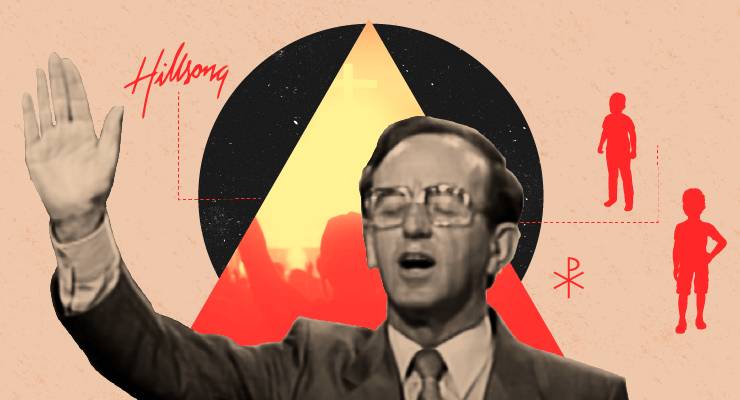
This article is the fourth part of Sins of the Father, a series on Brian Houston and Hillsong Church. For part three, click here.
Note: this article discusses child sexual abuse.
Frank Houston’s secret life as a prolific child sex abuser was obscured for decades by the late evangelical preacher’s enormous success where it most counts in corporatorised religion: bums on seats and money in the till.
Houston’s financial know-how set Hillsong on a path of ever greater riches. Once the first sex abuse claims emerged in the late 1990s and early 2000s, the church acted to limit any financial damage to its assets — with Houston and Hillsong entities paying victims little or nothing.
A new way of doing things: power to the preacher
Frank Houston arrived in Sydney from New Zealand in 1977 after building a hugely successful evangelical church in Lower Hutt. Houston brought a keen eye for business and a new approach to church governance.
He did not believe in governance by the congregation. Instead he instigated a system of governance by church elders — a small group of trusted people who were appointed by the senior pastor. They became directors of a corporate entity known as the Sydney Christian Life Centre.
Across town his son Brian Houston established a separate church using the same principles. Brian’s church was the Hills Christian Life Centre.
The corporate structure engineered by Frank Houston was to come in handy when trouble arrived in 1999 in the form of a claim of historical child sex abuse stretching back to the 1970s.
In mid-1999 Frank Houston suddenly and without explanation resigned as senior pastor of his church. Australian Securities and Investments Commission records show that Brian Houston stepped in at the same time as a director of Frank’s Sydney Christian Life Centre, while remaining a director of his own church.
It was the first in a series of moves which would ultimately see Brian’s Hills Christian Life Centre amalgamate fully with Frank’s church and absorb its multimillion-dollar inner-city assets, including land and buildings. By the end of 2000 Frank Houston was removed completely from the board of the church, and he had confessed to a second case of child sex abuse.
It was at that time that the entity the world knows as Hillsong came into being, bolstered by the jewel in the crown built by Frank.
Protecting the asset
Royal commission hearings in 2014 showed how determined Hillsong was to ensure Frank Houston’s abuse would not lead to any liability for a Houston entity. The hearings also revealed the coldly cynical actions Frank Houston had taken in dealing with the first accusations against him.
At issue was a claim that Frank Houston had in 1970 sexually abused seven-year-old Brett Sengstock in the Sengstock family home in Sydney. The abuse occurred when Houston was visiting Australia from New Zealand, before establishing his church in Sydney in 1977. In terms of legal liability, Houston was not attached to any Australian entity when he abused the young Sengstock — a fact which would later be used to deny Sengstock recourse to proper compensation or restitution of any kind.
The royal commission heard that when Houston became aware of the allegation against him in 1999 he organised to meet Sengstock — then in his 30s — at a McDonald’s restaurant. He promised to pay Sengstock $10,000, on top of a cheque for $2,000 he had previously sent. Houston was accompanied by another church elder — who sat eating a burger. Sengstock was asked to sign the elder’s soiled napkin.
Counsel for Brian Houston and Hillsong Church used his examination of Sengstock during the royal commission to tie him down to dates, and put it to him repeatedly that the abuse by Frank Houston must have occurred “at least four years before” the Sydney Christian Life Centre existed as a legal entity.
By the end of the questioning Hillsong’s counsel had what they wanted: Sengstock was forced to say he couldn’t recall “the exact times”.
With Frank Houston long dead by the time of the royal commission and his church off the hook in a legal sense, total payments to Sengstock came to $12,000. A lawyer who specialises in child sex abuse cases has told Crikey that compensation for Sengstock could have been between $1.5 million and $2 million in today’s terms, taking into account pain and suffering and loss of earnings.
The royal commission heard that the average payment for claims against the Catholic Church, for example, was around $90,000 over the period of 1980 to 2015.
Expansion by acquisition: going north
Brian Houston’s takeover of his father’s Sydney Christian Life Centre set up a pattern of expansion by acquisition that has been a hallmark of the Hillsong story.
From Sydney, Hillsong made its move into Queensland via an amalgamation with the Garden City Christian Church in Mount Gravatt, Brisbane. Garden City Christian Church — with more than 4000 regular Sunday attenders — amalgamated with Hillsong in 2009. The amalgamation was done through a vote of the church’s 900 or so “members” — a different class to attenders who have no voting rights.
A 75% majority of the vote was required to alter the church’s financial arrangements. The Houstons won with 79%. With it came, eventually, control over buildings and eight acres of land valued at some $8 million at the time.
The amalgamation infuriated some regular Garden City churchgoers. One complained that their church had “totally lost its identity.”
“Without a moment to breathe, the leadership from Sydney suddenly arrived putting their stamp on this new way to ‘do church’,” wrote former member Lance Goodall. “We were presented with a spokesman for this, and a spokesman for that. We even had a special ‘money preacher’ to encourage and remind us of the need to tithe and give generously.”
The incoming Houstons reportedly issued a statement to quell anger and offer assurances that church members would not lose control of their assets. Corporate records show that within five years the church’s registered office had moved to Hillsong HQ in Sydney with all directors being from Hillsong. In 2015, the last year for which records are available, the church’s net assets were valued at $11.68 million.
Sites in east and west Melbourne followed in 2012 and 2013. In each case a small and struggling Pentecostal church handed over its land and building assets to the control of Hillsong through its Sydney Christian Life Centre vehicle, which acquired yet more financial leverage to fund expansion. Former office holders of the smaller churches picked up roles with Hillsong.
A move west
In 2020, Hillsong hoovered up a struggling church in the northern Perth suburb of Joondalup. This church’s annual returns to the Australian Charities and Not-for-profits Commission (ACNC) paint a picture of an organisation in financial distress — a familiar story for smaller churches that can’t compete with Hillsong’s economies of scale and its overwhelming marketing hype. For its trouble, Hillsong added another asset to its pile, this one with land and buildings valued at $2.2 million.
Hillsong’s initial move into Perth led to a hand-wringing debate in the religious press, typical of the impact when the mighty Houstons roll into town.
“Where’s the upside?” asked pastor John Finkelde in an editorial. The answer:
1. Hillsong will reach Millennials and younger Gen X in Perth that many other churches won’t reach. This will include people who have never been to church or who have dropped out completely.
2. Believers needing a fresh start in church life will have that opportunity.
3. Churches lift their game when a church like Hillsong comes to town.
And the downside? Finkelde listed the following:
1. Some churches will suffer from a loss of members which can lead to a commensurate drop in resources.
2. A lot of pastors will be discouraged by Hillsong’s rapid growth. They know how to rapidly establish a church and will do so in Perth.
3. Pastors who have been struggling to grow their church will wrestle with unanswered questions. Small church pastors will especially feel this pain.
4. Some pastors will face a heightened level of anxiety especially if they are near Hillsong’s location.
5. Asking for expressions of interest on their Hillsong Perth Facebook Page may be seen as aggressively targeting active church members.
It might look like dog-eat-dog, but takeovers and acquisitions of smaller churches by megachurches are a regular occurrence in many parts of the world, according to Bruce Hills, who was pastor at Brisbane’s Garden City Christian Church for nearly nine years before the Hillsong amalgamation in 2009.
“I don’t necessarily see these acquisitions as a bad thing. Many dying churches have been revived as a result,” he said.
Hills says he had nearly suffered burnout under the workload of his ministry prior to the arrival of a new pastor. He had known Brian Houston for 40 years, considers him one of the most genuine and good-hearted people he knows, and was pleased that Hillsong had come in. He had also known Frank Houston and was “shocked” by the child sex abuse revelations.
The ever-growing Hillsong machine has looked after its own, with nearly all of Frank Houston’s original team now sitting at the table of Hillsong elders — or “The Eldership”, as the group is styled.
But working out where all the millions of dollars goes remains a mystery.
In Australia the federal government changed the rules on financial transparency for religious organisations such as Hillsong, which are classed as Basic Religious Charities. As a result since 2017 it has been impossible to follow a money trail.
It’s the same story in the United States where Hillsong is also registered as a charity.
The UK Charities Commission offers a glimpse into the church’s finances. According to Hillsong London’s 2019 report, Hillsong’s income was just on £20 million (A$38 million), with the majority being donations from church members. Its highest paid executive was paid in the range of $304,000 to $325,000.
It is, indeed, nothing short of a miracle — unless, of course, you are seeking compensation for being sexually abused by the empire’s founding father, Pastor Frank.
Read the full Sins of the Father series here.
Survivors of abuse can find support by calling Bravehearts at 1800 272 831 or the Blue Knot Foundation at 1300 657 380. The Kids Helpline is 1800 55 1800. Further support is available at Lifeline is on 13 11 14 and Beyond Blue is 1300 22 4636.
Survivors and Mates Support Network (SAMSYN) provides support for male survivors of child sexual abuse.
If you or someone you know is impacted by sexual assault or violence, call 1800RESPECT on 1800 737 732 or visit 1800RESPECT.org.au.








Crikey encourages robust conversations on our website. However, we’re a small team, so sometimes we have to reluctantly turn comments off due to legal risk. Thanks for your understanding and in the meantime, have a read of our moderation guidelines.